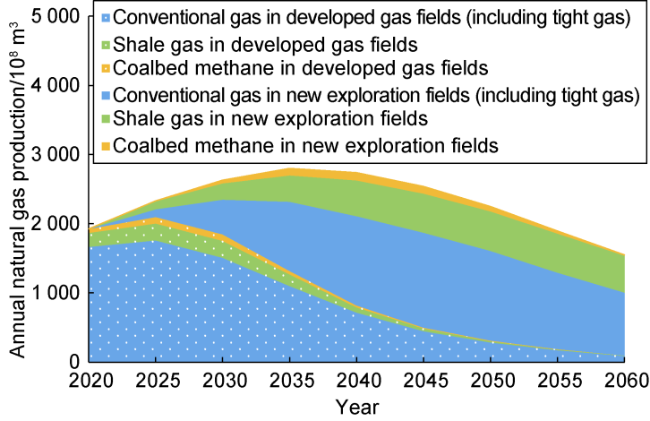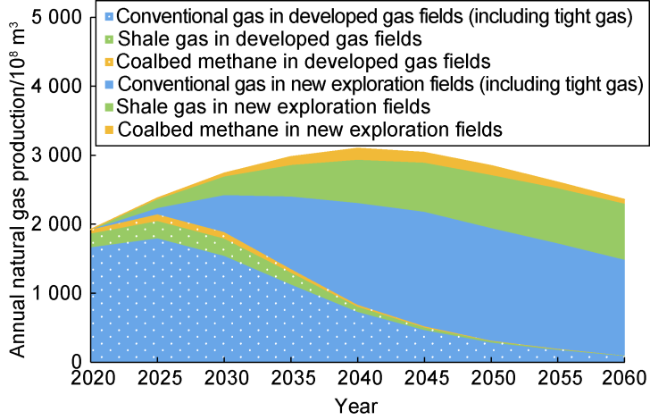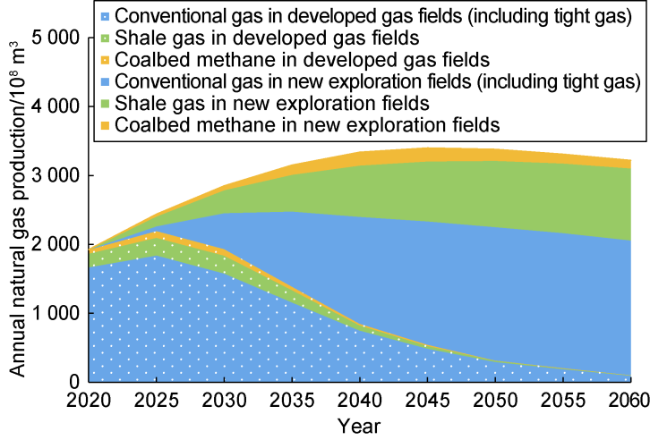Introduction
1. Forecast of natural gas consumption in China
1.1. Forecast model for natural gas consumption
1.1.1. BP neural network
1.1.2. LEAP model
1.1.3. Method for improving LEAP model
1.1.4. BP neural network-LEAP model
Fig. 1. Diagram of BP neural network-LEAP model. |
1.2. Parameter selection and scenario assumption
Table 1. Parameters for the three energy consumption scenarios |
| Consumption scenarios | Year | Share of electricity in terminal effective energy consumption/% | Annual hydrogen consumption/108 t | Comprehensive efficiency of terminal fuel/% | Comprehensive efficiency of electricity/% | Electricity transmission loss rate/% | Installed capacity of coal power generation/ 108 kW | Installed capacity of gas power generation/ 108 kW | Installed capacity of non-fossil energy power generation/ 108 kW | Carbon emission limit/108 t |
|---|---|---|---|---|---|---|---|---|---|---|
| Baseline Year | 2020 | 45 | 0.33 | 36.00 | 34.00 | 5.60 | 10.80 | 0.98 | 9.55 | 99 |
| Base scenario | 2040 | 50 | 0.50 | 36.50 | 34.50 | 5.00 | 8.64 | 1.47 | 23.88 | |
| 2060 | 55 | 0.70 | 37.00 | 35.00 | 4.50 | 5.40 | 1.96 | 33.43 | ||
| Technical advancement scenario | 2040 | 55 | 0.63 | 37.30 | 35.30 | 4.80 | 5.40 | 1.96 | 28.65 | |
| 2060 | 65 | 1.00 | 38.50 | 36.50 | 4.00 | 3.24 | 2.45 | 42.98 | ||
| Carbon neutrality scenario | 2040 | 60 | 0.75 | 38.00 | 36.00 | 4.50 | 65 | |||
| 2060 | 75 | 1.30 | 40.00 | 38.00 | 3.50 | 25 |
1.3. Forecast results and analysis
1.3.1. Terminal effective energy consumption intensity
Fig. 2. Goodness-of-fit of BP neural network sample set. |
Table 2. Prediction of terminal effective energy consumption intensity for different sectors |
| Year | Terminal effective energy consumption intensity (tce/person) | ||||
|---|---|---|---|---|---|
| Households | Industrial sector | Construction sector | Transportation sector | Other sectors | |
| 2020 | 0.109 9 | 0.868 4 | 0.023 3 | 0.105 5 | 0.145 7 |
| 2025 | 0.127 4 | 0.954 7 | 0.025 5 | 0.117 9 | 0.153 0 |
| 2030 | 0.134 8 | 1.000 6 | 0.027 4 | 0.125 3 | 0.160 4 |
| 2035 | 0.138 6 | 1.028 2 | 0.028 5 | 0.130 4 | 0.164 8 |
| 2040 | 0.140 5 | 1.042 4 | 0.028 9 | 0.132 2 | 0.167 1 |
| 2045 | 0.141 5 | 1.050 4 | 0.029 1 | 0.133 2 | 0.168 4 |
| 2050 | 0.142 4 | 1.057 1 | 0.029 3 | 0.133 8 | 0.169 4 |
| 2055 | 0.143 2 | 1.062 8 | 0.029 4 | 0.134 1 | 0.170 4 |
| 2060 | 0.143 8 | 1.067 1 | 0.029 5 | 0.134 2 | 0.171 0 |
1.3.2. Total consumption of primary energy
Fig. 3. Forecast of total primary energy consumption in China under different scenarios. |
Fig. 4. Forecast of energy mix in China under the base scenario. |
Fig. 5. Forecast of energy mix in China under the technical advancement scenario. |
Fig. 6. Forecast of energy mix in China under the carbon neutrality scenario. |
1.3.3. Carbon emissions from energy consumption
Fig. 7. Forecast of carbon emissions from energy consumption in China under different scenarios. |
1.3.4. Natural gas consumption
Fig. 8. Forecast of natural gas consumption in China under different scenarios. |
2. Forecast of natural gas production in China
2.1. Forecast method and scenario assumption
Table 3. Parameters for the three natural gas production forecast scenarios |
| Type of natural gas | Resources/ 1012 m3 | Current proven rate/% | Current remaining proven recoverable reserves/ 1012 m3 | Parameters for the base scenario in 2060/% | Parameters for the E&D technical advancement scenario in 2060/% | Parameters for the E&D technical breakthrough scenario in 2060/% | ||||||
|---|---|---|---|---|---|---|---|---|---|---|---|---|
| Proven rate | Reserve utilization rate | Recovery degree | Proven rate | Reserve utilization rate | Recovery degree | Proven rate | Reserve utilization rate | Recovery degree | ||||
| Conventional gas | 146.96 | 11.48 | 4.88 | 23.0 | 53.0 | 40.0-50.0 | 24.5 | 55.0 | 42.5-52.5 | 26.0 | 57.0 | 45.0-55.0 |
| Shale gas | 105.72 | 1.91 | 0.39 | 18.5 | 40.0 | 25.0 | 20.0 | 42.0 | 27.0 | 21.5 | 44.0 | 29.0 |
| CBM | 28.08 | 2.61 | 0.31 | 10.0 | 42.0 | 30.0 | 12.0 | 44.0 | 32.0 | 14.0 | 46.0 | 34.0 |
2.2. Forecast results and analysis
Fig. 9. Forecast of natural gas production in China under the base scenario. |
Fig. 10. Forecast of natural gas production in China under the E&D technical advancement scenario. |
Fig. 11. Forecast of natural gas production in China under the E&D technical breakthrough scenario. |












